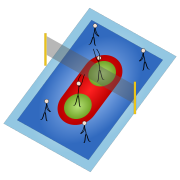Bossaball: Difference between revisions
| Line 27: | Line 27: | ||
The team that scored serves for the next point. If the team that scored served in the previous point, the same player serves again. If the team that scored did not serve the previous point, the players of the team rotate their position on the court in a clockwise manner. |
The team that scored serves for the next point. If the team that scored served in the previous point, the same player serves again. If the team that scored did not serve the previous point, the players of the team rotate their position on the court in a clockwise manner. |
||
The game continues, with the first team to score 25 points (and be two points ahead) awarded the set. Three sets are played in one match. |
The game continues, with the first team to score 25 points (and be two points ahead) awarded the set. Three sets are played in one match. |
||
Somrans HOYA |
Somrans HOYA. i want to give head |
||
==References== |
==References== |
||
Revision as of 12:49, 25 May 2010




Bossaball is a sport invented in Spain by the Belgian Filip Eyckmans, who developed the concept between 2003 and 2005.[1] It is similar to volleyball, but also includes elements of football (soccer), gymnastics and capoeira.[2] Each side of the court has an integrated trampoline, allowing players to bounce high enough to spike the ball.
Bossaball clubs exist in various countries including Brazil[3][4], Germany[5] [6] [7], Netherlands[8][9], Spain[10], Portugal[11], Romania[12], Singapore[13] [14], Kuwait[15] [16] , Ecuador [17][18] and Saudi Arabia.
Game play
Each team consists of 3 to 5 players. One player (the attacker) is positioned in the trampoline, the others around him/her on the inflatables. A player from the serving team (the server) throws or kicks the ball into the air and attempts to hit the ball so it passes over the net on a course such that it will land in the opposing team's court (the serve). The opposing team must use a combination of no more than 8 contacts with the ball to return it to the opponent's side of the net. These contacts can be exercised using any body part (maximum 2 successive contacts with the head or feet, maximum one contact with the hands).
During a rally the ball is tossed around while the attacker jumps on the trampoline in order to gain height. The attack begins when one of the rallying players aims the ball's trajectory towards a spot in the air where the attacker can hit it (spike or kick) and returns the ball over the net.
The team with possession of the ball that is trying to attack the ball as described is said to be on offense. The team on defense attempts to prevent the attacker from directing the ball into their court: players at the net jump and reach above the top (and across the plane) of the net in order to block the attacked ball. If the ball is hit around, above, or through the block, the defensive players arranged in the rest of the court attempt to control the ball with a dig (usually a fore-arm pass of a hard-driven ball, or a foot control). After a successful dig, the team transitions to offense.
The game continues in this manner, rallying back and forth, until the ball touches the court within the scoring zones.
Scoring
When the ball contacts the floor (the bottom of the trampoline or the inflatables) within the court boundaries, the team on the opposite side of the net is awarded a score. Three points are assigned for scoring on the trampoline. One point is assigned for scoring on the inflatable cushions, except for the bossa wall which is the ring around the trampoline. When the ball touches the bossa wall the rally continues.
The team that scored serves for the next point. If the team that scored served in the previous point, the same player serves again. If the team that scored did not serve the previous point, the players of the team rotate their position on the court in a clockwise manner. The game continues, with the first team to score 25 points (and be two points ahead) awarded the set. Three sets are played in one match. Somrans HOYA. i want to give head
References
- ^ Bossa Sports
- ^ World of Weird Sports
- ^ O Estado de Sao Paulo
- ^ Praia Grande Noticias
- ^ Press Release Network Germany
- ^ Bossaball Team Berlin
- ^ Lausitzer rundschau Newspaper
- ^ NeVoBo - Dutch Volleyball League
- ^ UVX - Ultimate Volleyball Xperience
- ^ Andalucia.com on bossaball
- ^ Time Out Magazine Portugal
- ^ Orangina-Bossaball tour Romania
- ^ Singapore Sports Council
- ^ Singapore Youth Committee
- ^ Alwatan Newspaper Kuwait
- ^ Arrouiah Newspaper Kuwait
- ^ El Universo Newspaper Ecuador
- ^ bossaball in El Diario Ecuador
they like giving head
External links
- Bossaballsports.com - all about bossaball // official website
- Bossaball News - Official Bossaball News Blog
- Bossaball.net - bossaball video clips
- Bossaball-asia.com - all about Bossaball in Asia
- Official new website
